这篇文章是物理(人机)交互原理的松散集合。其中一些是从丹·奥沙利文和我的《物理计算》一书中摘取的,还有一些是在教学和构建交互系统的过程中开发的材料。我在不同的场合做了不同的演讲,通常每一年ITP的物理计算入门课程都是从它开始的。现在把这些资料整理出来,希望还不是太晚。
交互的定义
在我们进一步讨论之前,我应该定义一下我所说的交互性。这里我喜欢游戏互动大师Chris Crawford的定义:
“发生在两个或多个活跃主体之间的循环过程,各方在此过程中交替地倾听、思考和发言,形成某种形式的对话(conversation)就是交互”-Chris Crawford, Designing Interactivity
关键是循环. 也就是完整的交流不会以单次的对话或者只动作和反馈一次结束, 而是必须有一个持续的对话,必须有一个话题要谈。一个参与者的行为引起另一个参与者的回应。前者与后者进行循环多次的持续对话,才是一个互动的对话。参与者不一定非得是人,他们可以是人,也可以是机器。但他们的行为必须在某种程度上相互理解。T
Describe the form and the behavior
当设计师描述交互式装置时,他们通常会非常详细地描述控件、显示以及参与者在遇到装置时所看到的景象和声音。
通常,他们忽略了谈论他们为谁设计的:他们是谁,他们将被期望对装置做什么,为什么他们会被激励去做。如果你不能激励参与者按下按钮或走进房间,互动就永远不会发生。
这是我在大学和早期职业生涯中与演员和导演合作时一直坚持的一条原则:你不能告诉一个演员该做什么。为了采取任何行动,演员需要自己找到行动的动机。导演、剧作家和设计师的角色是提供一个条件,在这个条件下,动机会被发现。同样,交互设计师也不能告诉他们的观众该做什么。我们只能提供一个环境和背景,让他们能够理解所给出的提示所期望的行动。
有表现力, 有建设性, 有指导意义
在讨论物理交互项目时,了解项目创建者的目标是很有用的。这在对项目提供关键反馈时特别有用。在我教过的物理计算课程中,有几类项目经常出现:表现性作品、工具或工具以及教学作品。
表现性作品往往是最不直接的互动,因为他们通常是关于表达艺术观点。在参与和控制故事之间有一个平衡:参与的程度越高,决定故事出现的参与者就越多,而不是设计者。有表现力的作品的创作者通常在他的作品之外还能传递更多的信息。图像、声音、动作是多媒体工具用来讲述这个故事的要素。参与者可以通过做你不期望或不希望他们做的事情,或者完全忽略某些元素来改变故事的方向。表达性项目对于学习物理系统的控制、故事的节奏、结构和控制,以及美学选择的效果都很有用,就像任何表达性作品一样。 并非所有涉及数字技术的艺术都必须是互动的。我觉得很多艺术家很难放弃作者的声音,把观众也包括进来。没关系。有时候你只是想做一些漂亮的东西,比如下面马修·理查德的彩色机器人。然而,了解交互式作品和使用交互式工具制作的作品之间的区别是很有用的。
Estrella Intersects the Plane by Matthew Richard.
许多互动作品都是乐器,比如弦乐,一种房间大小的乐器,由路易莎·佩雷拉、莫妮卡·贝特·维达尔和约翰·戴德里克创作,如下图所示。这是一个互动作品的例子,创作者在这个作品上打下了明显的审美印记,然而参与者通过他们的参与完成了作品。由于其明显的脆弱性,该工具为参与者提供了许多不同的表达行为,同时也暗示了他们可能不会做的事情。例如,你不会想坐在琴弦上。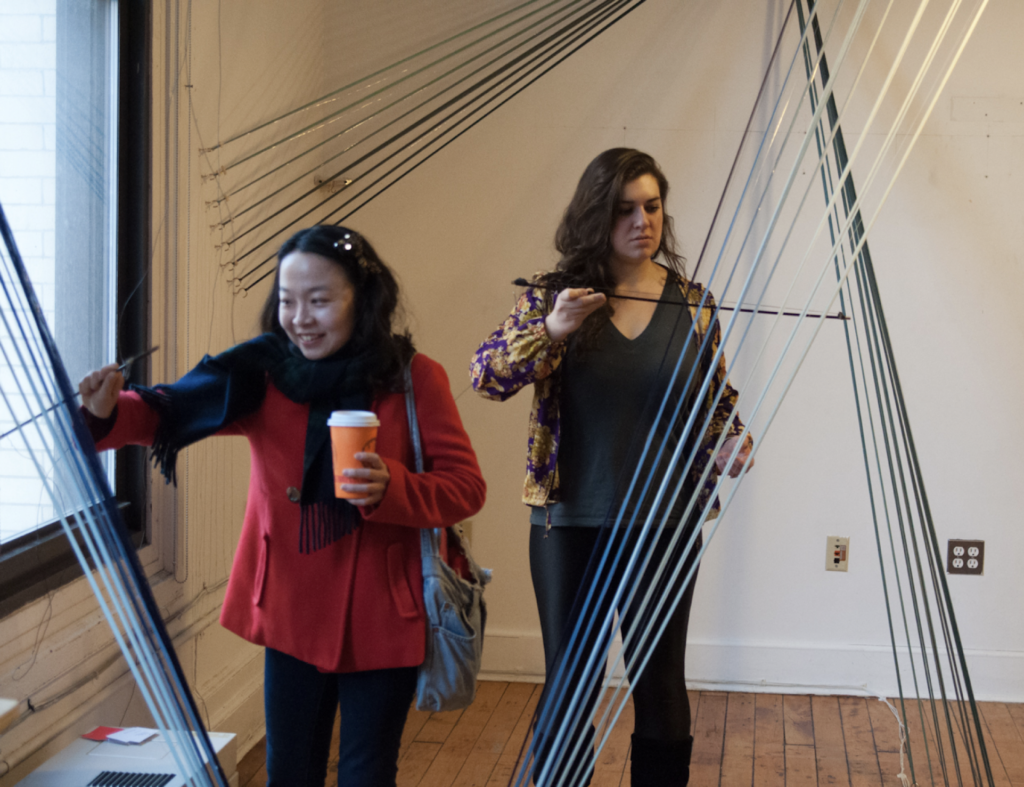
Strings, a musical instrument. By Luisa Pereira, Monica Bate Vidal, and Johann Deidrick.
有些仪器是日常使用的工具,如下面所示的自定义PS3控制器。这是为了配合照片中年轻人的特殊能力,他上半身的活动能力有限,但可以移动他的头和一只手。
有指导意义的项目是第三个流行的类别。这些作品旨在通过直接的经验来传达一种思想。他们相信你可以通过直接的行动和操纵来学习东西,而这是其他任何方法都学不到的。通过这些,你内化了一个想法,通过直接的经验,如吉尔海菲尔的 Human:Nature 项目,其中参与者戴着一副耳机,里面装着活蟋蟀,并用一个网罩将它们与耳朵隔开。蟋蟀的直接听觉体验不同于任何蟋蟀的录音。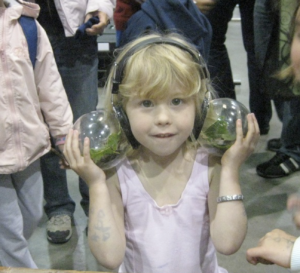
Human: Nature by Jill Haefele.
下一个作品,《 How You See》,由布雷特·彼得森,陈雪迪,汤姆·亚瑟和汉娜·米辛,是另一个教学作品的例子。作为博物馆展品,它通过视频向你展示你眼中的视杆和视锥实际上看到了什么。参与者通过插入或拔下代表眼睛不同感觉细胞连接的耳机插孔,改变眼睛在屏幕上看到的图像。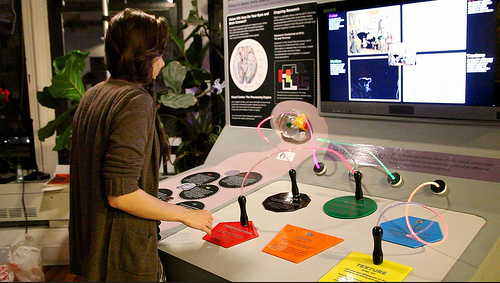
How you see, by by Brett Peterson, Xuedi Chen, Tom Arthur, and Hannah Mishin
传感器
因为我们的共同,经历人类可以理解很多关于彼此的行为和动机。即使没有语言,我们也会对彼此做出一些通常是正确的假设。然而,当我们与机器交互时,我们不能做出这些假设。机器不明白我们可以思考,甚至不知道思考意味着什么。他们只能通过我们身体通过我们的身体活动产生的物理能量的变化来解读世界。机器不会读到你的意图,只会看到你的行为。
转换是一种能量形式转化为另一种能量的过程。在电子技术中,传感器是将或导入其他形式的能量转换成或从电能转换的元件。传感器通常分为两组。传感器将光、热、气压和其他形式的能量变化转化为电能。执行器将电能转换成光、热、运动和其他形式的能量。计算机可以读取和写入电能的变化,所以传感器和执行器是计算机的感官和肌肉。
物理交互也涉及到感知与转换——这一点很重要,要记住,因为你在制作交互系统时使用的计算机除了从参与者产生的能量变化中可以感知到什么之外,对参与者一无所知。电脑不能读懂他们的思想,只能读懂他们的动作。
数字和模拟
传感器和执行器及其感知和控制的动作可分为两组:数字和模拟。数字传感器和执行器,有时称为二进制传感器,可以检测或控制两种状态,开或关。模拟传感器和执行器可以感知或控制不断变化的状态范围。记住区别的一个简单方法是把猫放在垫子上。数字传感器可以告诉你猫是在垫子上,还是不在垫子上。模拟传感器可以告诉你垫子上的猫有多胖。
尽管模拟传感器通常被称为连续传感器,但实际上,读取这些传感器的计算机测量的可能值是离散的。例如,一个典型的微控制器可能能够读取一个力感应电阻器(在上面的cat上使用)产生的电阻变化,分辨率为1024个可能的离散状态。传感器或执行器的分辨率决定了您能够感知或控制手上动作的精细程度。 当你描述一个参与者将要采取的行动时,问问自己你需要知道多少关于这个行动的信息。知道这件事发生与否就足够了吗?如果是这样,那么数字传感器就可以完成这项工作。或者你需要知道一系列可能的行为状态吗?如果是这样,那么你可能需要一个模拟传感器。
直接和间接的交互
物理交互可以是间接的(隐式的),也可以是直接的(显式的)。这样可以将一个人的意图和他们所采取的实际行动联系起来。显式交互是指参与者的行为主要是向计算机发送信息。就像按下按钮。一个明确的行动的物理启示应该是清楚和明显的,并且感知通常局限于一个非常封闭的区域。隐式交互还有其他一些主要目的,向计算机发送消息是次要的效果。门口入口传感器、自动水龙头传感器和其他运动检测器可以支持隐式交互。物理上的启示可能并不明显,而感知可能跨越一个广阔的领域。区域过宽可能导致错误触发。
The physical affordances may not be obvious, and sensing may be across a wide area. Too wide an area may result in false triggering.
显式交互。演员轻敲圆顶产生交互效果。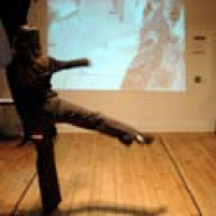
隐性互动。舞蹈者跳舞以表达自己的意思。传感器捕捉她的运动并将其转换为屏幕上的图像。I
Examples of sensors for explicit interaction: pushbuttons, knobs, sliders, keys, card swipers
Examples of sensors for implicit interaction: door entry sensors, floor triggers, faucet sensors, motion detectors.
Wendy Ju developed a framework for implicit interaction as part of her dissertation, and has a good book on the design of implicit interactions.
“What should I do here?”

Noise Nest, by Jeremy Diamond.
Interactive art breaks the rules of traditional plastic arts. With painting and sculpture, we know our role as viewers. We look but don’t touch. Interactive art is not always so clear. We don’t yet have an historical context for interactive art: should we touch, should we not touch? Should we watch and nod appreciatively? Should we dance and jump around frenetically? What’s acceptable? There’s no commonly expected response that audience members can either follow along with, or defy, as there is in the traditional plastic arts. It is important that artists who make interactive work set the expectations for the audience. If you want them to explore, you can make it vague, but give them something evocative, ike the soft, inviting fur texture of Jeremy Diamond’s Noise Nest sculpture shown in the previous image.
Quite often, the default for this kind of work is to leave things very open. This hasn’t changed for a lot of years. For example, consider one of the germinal works of interactive computer video art from Myron Kruger in the early 1970’s in the video below.
The video below is my colleague Danny Rozin’s Wooden Mirror from 1999…
And the video below shows is what we do with the Kinect as of 2011:
We’re still waving at the machines. Well, dancing now.
Ways to Generate Action
Use active verbs
One way to think about what your participants will do is to describe then using active verbs. Active verbs address what a person is to do, not just what they are to be. “To jump” is an active state. “To be scared” is not.
Actors need things to do. Give them actions, not states of being. If there is action and context, they’ll figure out the meaning.
In Channels, a project by Alvin Chang,Ginny Hung, and Suzanne Kirkpatrick, shown below, the visitor rows a virtual boat by paddling her hands in the water. The boat, the reeds, and the video in front of her all set up the context and suggest the action.
Channels, by Alvin Chang,Ginny Hung, and Suzanne Kirkpatrick
Break Down Inhibitions
When faced with the unfamiliar, people get defensive or self-conscious. If you can make participants feel comfortable and safe, you’ll break down their inhibitions and get them more engaged.
In Intimate Toilet, Jiyhyun Lee and Jihyun Moon inserted elements of the their own personalities to break down inhibitions. The project was designed to make users more comfortable using a squat toilet. They used lots of positive reinforcement and a little humor to get you comfortable. The narrative of the video and the fantastic unicorn and rainbows imagery give you a good sense of the tone of the piece. The video is controlled by a handle next to the toilet.
Give people reasons to cooperate
Most interactive experience (and in fact, I’d argue most games as well) are excuses for people to make contact with each other, to have a conversation. When we learn the necessary rules and actions, then forget that we’re doing them, it leaves space for us to talk. The ‘Roseabelle’ Ouija Board by Ruxandra Staicut, Sonaar Luthra, and Si Cho exemplifies this in the video below:
Give people reasons to compete
Competition is another way to get conversation going, so when you use it, make sure the competitors get to focus on each other. Dynamic Canvas by Eunyoung Kang and Sukmo Koo, shown in the next image, has participants facing each other as they blow on sensors to move a ball across a projected landscape.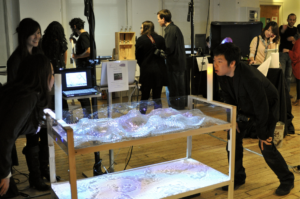
Dynamic Canvas by Eunyoung Kang and Sukmo Koo
Find the moment between decision and action. Engage.
The moment to influence a participant’s action is right after they decide to take action but before they take it. Mouna Andraos, Michael Kertesz, and Jun Oh found this moment for users of the elevators at Tisch. They wanted to change your mind when you’d decided to take the elevator, to encourage you to take the stairs. Using an overhead camera focused tightly on the elevator button, they captured the moment right before the button is pushed, and distracted the participant.
Video Player
You can’t enforce interaction
People don’t have to interact with your work. They don’t even have to pay attention to it. So you don’t get to enforce anything, you just get to suggest, and hope they stay with you, as this behind-the-scenes video from the elevator tracking project above shows.
Video Player
Use the whole body
Most devices we use don’t ask us to use our whole body, but most people welcome the chance to do so. Give participants that chance and you’ll make things more fun for them, as in The Big Bounce, a musical instrument by Christina Goodness that takes the full effort of jumping and bouncing to make music.
The Big Bounce by Christina Goodness
Give people reasons to use the whole space
Bodies can fill a space, if you give them the means to do it. Given permission and means to run (or swing) around the whole space as well, participants will gladly do it, as in this musical instrument, Swings, by Claire Mitchell, Engin Ayaz, and Patrick Muth.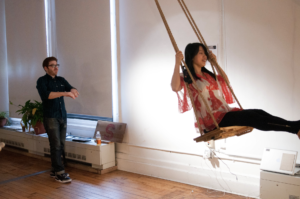
Swings, by Claire Mitchell, Engin Ayaz, and Patrick Muth
Nothing is intuitive. Everything is learned.
As designers, we tend to call things intuitive when we think it’s obvious. But obvious means different things to different people. Intuition is what happens when we see something new that reminds us of something familiar. No interface is universally intuitive, and if you think yours is, you’ve lost empathy for your audience. Kate Hartman’s Talk to Yourself Hat examines the notion of intuition by offering an “intuitive” interaction that is nonsensical.
Differentiate automation from interaction.
If you look at many connected devices on the market currently, there is a strong bias towards automation. The internet of things is all about listening, measuring, and quantifying. But interaction is about enhancing, rather than replacing, what we do best. The most engaging interactive works strike a balance between these two.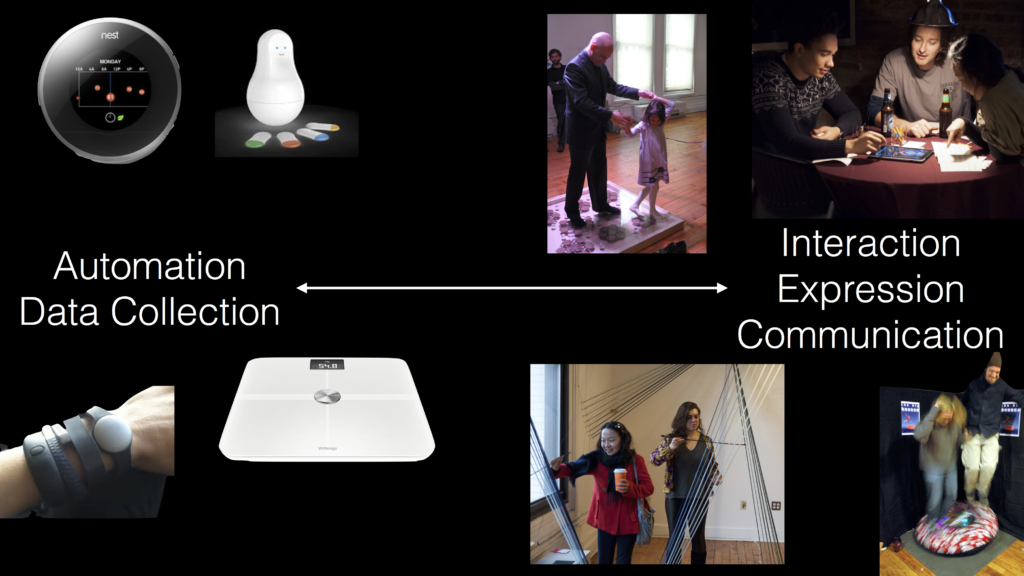
Interaction vs. Automation
The things we make are less important than the relationships they support
Finally, remember who you’re designing for. If you forget them, there’s not much point. Justin Lange’s Folkbox modified guitar embodies this ideal. The guitar he built was designed to restore his father’s ability to play guitar after an accident limited the motion in his hand. Designed for an audience of one, it involved considerable conversation and observation to match the affordances of the instrument with the capabilities of the musician.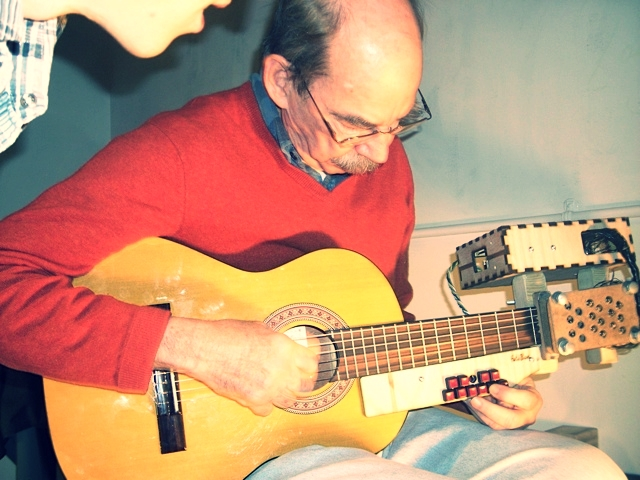
Justin Lange, Folkbox

